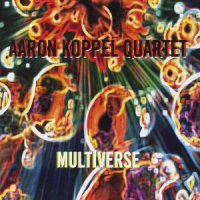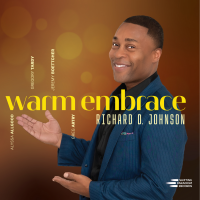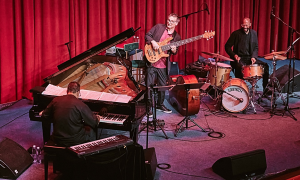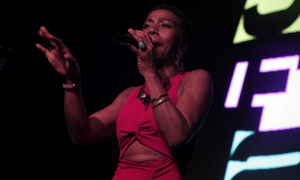Home » Jazz Articles » Profile » Gareth Lockrane: Doing That Grooveyard Thing
Gareth Lockrane: Doing That Grooveyard Thing

Lockrane hails from Stoke-on-Trent, in Britain's North Midlands. It's not a prepossessing kind of place. Justly famous for the quality of its ceramics—the names Wedgewood, Doulton, Spode and Minton and thirties designers like Clarice Cliff, Susie Cooper, Keith Murray and Charlotte and Frederick Rhead are known the world over— the area suffered greatly from the closures of its steel works, its coal mines and other heavy industries through the seventies, eighties and nineties. Whilst it remains an important centre for pottery, Stoke and the other "Five Towns" have suffered from the both unfavorable economic winds in recent decades, as well as from the blight of sixties-style town planning. It's the kind of place that might produce, let's say, a Robbie Williams, but hardly a major new jazz talent like Gareth Lockrane.
Gareth Lockrane is what might be called an emergent talent. He's not one of those guys who shines brightly, then all too often crashes and burns. His trajectory has been quite slow but, with hindsight, he's been coming in to view for some years now. Having first heard him on saxophonist Tom Richards Orchestra's Smoke and Mirrors (Candid, 2007) and his gorgeous solo on "Liquor Bickering," the second time was with a group of young British musicians performing with drummer Jack DeJohnette at the Cheltenham Jazz Festival in 2009. Lockrane can also be heard on guitarist Phil Robson's The Immeasurable Code (Whirlwind, 2011), sharing frontline duties with American saxophonist Mark Turner. There is something about the strength of his sound, the way it cuts through the mix, and how confident he sounds in Turner's righteous company.
All reasons enough to check Lockrane out more closely, but with his third album as a leader, The Strut (Whirlwind, 2012), just released it seems high time to spread the word. The Strut is the second album from Grooveyard, one of three current Lockrane ensembles—there's a septet and a big band as well. The first Grooveyard record, Put The Cat Out (Gailforce), came out in 2003, and in the intervening years Lockrane attended the UK's National Film and Television School in Beaconsfield, where he studied for a Masters in film composition. The first question is about how he sees the differences between the new CD and its predecessor. One change seems to involve a greater sense of emotional immediacy with the The Strut.
"That could be connected to film school," he says. "Whatever influence there is is probably unconscious because, I suppose, a lot of these tunes maybe started to be written around that time at film school and I guess I've checked out a lot more music in the meantime. I think with the music on the first one, I was trying to update that whole soul jazz, organ tradition. Unashamedly so because I do love all that side of the music. I was trying to keep the core elements but trying to update it with modern melodies without turning it into a fusion band. For me, it should always sound like a good-time soul band but with all those extra things that say [guitarist] John Scofield brings in. It always feels like he's jamming a tune, however crazy and complex it is. That was the thing on the first one and on this one probably it was about stretching things harmonically beyond what.... I usually write with the organ in mind but I wanted to push things harmonically with the writing and arranging, trying out different arranging colors within that lineup. Maybe I couldn't see those possibilities ten years ago."
It was clearly important for him to take on the challenge offered by the National Film and Television School and it was a decision that emphasizes both Lockrane's ambition and his commitment to music. His studies there seem to have led to an emphasis on economy rather than brevity in his compositions. If so, then how exactly has he achieved this?
"I think the most obvious impact," he explains, "involved getting into writing minimal melodies and slowly unfolding harmonies-getting into that zone, in particular, because we were mostly doing short, narrative-based films where every note counts and where a few unnecessary musical gestures could throw the whole thing completely. The whole course is built around making short films. You're writing music for a team effort. Often, you end up trimming things down to pretty minimal writing but really trying to consider what you need to communicate with the music.
"It was a really healthy time—back-to-back projects, not knowing how they were going to pan out but just having to dive in there as part of a team situation," he continues. "And, of course, working with non-musicians was a huge thing. You get so used to talking in 'muso' shorthand. With other musicians you take so many things as read and don't question what it is you're trying to communicate with your writing. When you're collaborating with non-muso characters you have to think 'What is this?,' 'What is the music required to communicate?' So, that's a whole new angle really—'What is this piece trying to do?' In a jazz context, you're using an established structure, but with film projects it's more about moving from A to B, from beginning to end."
The music certainly is, at times, filmic but there's no sense that these tunes need visual images to come alive. They have movement and flow and there's a lithe grace and even elegance to pieces like "One For Bheki" (of which and of whom more shortly) and "Memories In Widescreen," and an earthiness to the title track and the opener, "Frizz." In fact, there's almost a hint of Lalo Schifrin about the latter. However, this is also music filled with sly twists and surprises. It might sound relaxed on the ear but it's multilayered and assured as well. Take the Roland Kirk-inflected "Whistleblower." It has almost a samba feel but there's something else going on to, as the piece threatens to become totally unhinged at various points, whilst "Method In The Madness" moves between hard-bop and Latin jazz with consummate ease. But, then, this is a very sharp, tight quintet.
Saxophonist tyro Alex Garnett kind of co-leads Grooveyard. Still young himself, Garnett's something of a cult figure to London's even more youthful young saxophonists; there's a Stanley Turrentine quality and vigor to his playing. Ross Stanley, on Hammond organ, not only has great chops, but he swings and the sound he gets from the organ is simply lovely—full-fat but never greasy—while drummer Nick Smalley is a beast; Lockrane describes him as "this insane, tattooed maniac," certainly a compliment. That leaves Mike Outram, a wonderfully accomplished musician and one of those guitarists who just seems to have it all in the tips of his fingers, and, on several tracks, singer Nia Lynn. Lynn plays with Ross Stanley and Lockrane in the Bannau Trio and the tone of her voice is just beautiful.
If the inspiration for Grooveyard lies in the sixties/seventies organ-led soul jazz of guys like saxophonist Eddie Harris, Turrentine, pianist Les McCann and organist Jimmy Smith, Lockrane's septet is something else again. In a way, it's more of a vehicle for Lockrane's compositional ambitions and the group's No Messin' (Gailforce, 2008) won the prestigious All-Party Parliamentary Jazz Appreciation Group award for best CD in 2010.
"With the septet, during college and even before that, I'd always been into arranging and composing for larger groups," Lockrane points out. "So, with the septet there was more of a focus on having an acoustic piano trio with horn arrangements, just trying to get into the vibe of that. At the time, I was really listening a lot to Jimmy Heath and Tadd Dameron and the more contemporary guys like Jim McNeely and Walt Weiskopf. Trying to get into those kinds of zones a little bit but also trying to find a place for the flute in a larger ensemble. So, I was using a lot of alto flute trying to find a context for the instrument in a more large scale environment."
No Messin' clearly comes from the same pen as The Strut, but has more of a metropolitan jazz club feel compared to the quintet's roadhouse groove. More than that, Lockrane has then been able to pool the resources of both groups to create a big band that extends the possibilities of his unusual compositional skills still further, allowing him to explore influences as diverse as trumpeter Kenny Wheeler, arranger/orchestrator Don Sebesky and composer/arranger Maria Schneider alongside pianists Duke Ellington and Count Basie, and bassist Charles Mingus as well. As he explains, "It was just a way of getting a long-running project together where I can develop the writing, and it's gone on for about three years and I'm really happy with how it's progressed. A lot of world-class musicians have given up their time and been up for it, which is great and given me the confidence to carry on with it." Keep watching—there should be a live album next year.
There's a fine attention to detail about Lockrane's work that extends to the way his music is presented and to exceptional cover art and graphics that decorate the sleeves of his CDs, courtesy of old friends Bill Bragg and Matt Wiley. Wiley is responsible for the overall design, whilst Bragg does the cover.
"We're old friends," Lockrane says. "I really think when you get an album you should be into it before you've even put the first track on—the artwork and the design, it's all got to be one thing. Bill's fantastic. There's a lovely link, actually. We were basically friends before we were even born because our dads both taught at the same college—my dad taught illustration and his dad taught graphics at what was Stoke Polytechnic and is now Stafford University. We're still best friends. The funny thing with the first album with the two cats—that caricature of Alex and me—we had done a load of photos where we were trying to look mean and edgy and he took one look at these pictures and sat in a corner doodling away and came up with these perfect cat icons of us two that seemed to sum up the whole thing. He just brought out the humor side of it and communicated that and it suited the music. I love what he does."
Lockrane's eye for detail may perhaps owe something to his dad. But his love of music and of film also stem from a rich and fulfilling upbringing at home and in the area of Staffordshire in which he grew up. His dad played chromatic harmonica and a bit of flute as well.
"He played a really kind of mean blues flute in 'G,'" he says laughing. "So, I was used to having this bluesy flute sound in the house. The first things I heard as a baby were James Clay, Frank Wess and Roland Kirk—just these sounds around the house from my dad. I got my first instrument when I was ten and got into jazz off my own back when I was about 14 by joining the school jazz group with some brilliant, supportive characters like my teacher at school and people on the Midlands jazz scene like Chris Gumbley, who ran a jazz club in Stafford. He was a huge influence when I was a teenager. He ran a jazz evening class in Stoke-on-Trent, where I lived back then. For a teenager's first jazz club, he ran the perfect place in Stafford, this smoke-filled room where Chris would often do this solo saxophone spot between the main sets and I'd see all these London guys come up to play. I used to have this 20-mile cycle ride to see the gigs at his club when I was a kid."
"Memories In Widescreen," from The Strut, is, in a sense, a tribute to his father, who died a few years ago. "That was about being a kid, going to the cinema with my dad," he says, "and just that feeling of the curtains opening on this huge widescreen and the whole scope of that. I just used to love that feeling. I guess I was trying to get into those internal memories of that and my dad passed away a few years ago and he really got me into music in the first place. So, it's memories of my dad and going to the movies. I think I wrote that tune round about the time I went to film school. The melody is fairly minimal and, as I said, that was the huge influence of film school because we were all encouraged to write less using minimal melodies and slowly moving harmonies. It was all these things coming together at once."
Lockrane studied for his first degree at the Royal Academy of Music in London with British jazz stalwarts such as saxophonists Stan Sulzmann and Mark Lockheart, flautist/keyboardist Eddie Parker and trombonist Hugh Fraser. It was there also that he struck up musical relationships with fellow students, trumpeter Steve and drummer Matt Fishwick, bassist Orlando le Fleming and saxophonist The Osian Roberts/Steve Fishwick Quintet. In 1997, his band The Jazz System, formed with Roberts, was a finalist in the Vienna Jazz Festival Grande Concours de Jazz. In 1998, he studied on the Lake Placid Jazz Course in New York with saxophonists Joe Lovano and Dick Oatts, and composer/arranger Jim McNeely and in 2000 he was a finalist in the BBC's Young Jazz Musician of the Year competition. Flautist Eddie Parker has proved an enduring influence and connects Lockrane with another important figure in the young man's life—the late and much-loved South African musician and composer Bheki Mseleku. Parker, of course, played on Mseleku's feted, first album Celebration (WCD, 1992). Lockrane was into Mseleku's music even before he went to the Royal Academy but only met him in 2006, two years before the South African's death from an illness related to his diabetes. Following a duo rehearsal together, Lockrane began working with Mseleku
"Basically from then on," Lockrane explains, "we did endless amounts of duo blows and quartet and trio and quintet gigs. He couldn't write down his own tunes, so we'd do these long rehearsals where I'd video his fingers to get the voicings just right and transcribe and learn all these epic tunes of his. There were loads of new things that haven't been recorded. So, it was an incredible relationship and that was running parallel to film school. It was a really exciting time with all these things colliding at once and getting a whole wave of new influences coming in at the same time and just playing with Bheki and trying to get into the mind of one of your heroes. We had some fantastic gigs together with a few little tours. Steve Rubie at the 606 Club in Chelsea was a massive support. We used to play there every month."
"Bheki was this larger than life personality," he adds. "The sheer projection and whole compositional scope of his music—for me, he is one of those great writers. His compositions have this inevitable flow about them. Once you've heard the whole thing, it's like that was the only way it could have gone, no matter how many surprising twists there are in the tunes. It just feels that it could only have gone that way. These are the only gigs I've done where the whole audience was singing along to these great hooks and all the musicians are sweating it out on stage with their eyes fixed on the charts. It was a great time for me."
In fact, the times seem to get better for Lockrane. His reputation is growing and The Strutwill take that to a higher level still. Whether it's playing in Grooveyard or his septet, leading his own big band or playing with Phil Robson's quintet, Lockrane is becoming a key figure in a very healthy UK jazz scene. Playing opposite figures like Mark Turner or with giants like Jack DeJohnette inspires him but it doesn't faze him. He also seems like a really nice guy. He laughs easily in a way that suggests that he takes his music more seriously than he does himself. Growing up in the British Midlands in a strong and supportive family environment has given him roots which give his writing—and his playing—a depth and a quality unusual in one still so young. Like the man, like the music, in every sense.
Selected Discography
Gareth Lockrane's Grooveyard, The Strut (Whirlwind, 2012)
Phil Robson, The Immeasurable Code (Whirlwind, 2011)
Gareth Lockrane Septet, No Messin' (Gailforce, 2008)
Tom Richards Orchestra, Smoke and Mirrors (Candid, 2007)
Grooveyard, Put The Cat Out (Gailforce, 2003)
Tags
Gareth Lockrane
Profiles
Duncan Heining
United Kingdom
London
Herbie Mann
Hubert Laws
BOBBI HUMPHREY
Jeremy Steig
Paul Horn
James Newton
Tom Richards
Jack DeJohnette
Phil Robson
Mark Turner
John Scofield
Lalo Schifrin
Roland Kirk
Alex Garnett
Stanley Turrentine
Ross Stanley
Nick Smalley
Mike Outram
Nia Lynn
Eddie Harris
Les McCann
Jimmy Smith
Jimmy Heath
Tadd Dameron
Jim McNeely
Walt Weiskopf
Kenny Wheeler
Don Sebesky
Maria Schneider
duke ellington
Count Basie
Charles Mingus
James Clay
Frank Wess
Stan Sulzmann
Mark Lockheart
Eddie Parker
Matt Fishwick
Orlando le Fleming
Osian Roberts
joe lovano
Dick Oatts
Bheki Mseleku
606 club
PREVIOUS / NEXT
Support All About Jazz
 All About Jazz has been a pillar of jazz since 1995, championing it as an art form and, more importantly, supporting the musicians who make it. Our enduring commitment has made "AAJ" one of the most culturally important websites of its kind, read by hundreds of thousands of fans, musicians and industry figures every month.
All About Jazz has been a pillar of jazz since 1995, championing it as an art form and, more importantly, supporting the musicians who make it. Our enduring commitment has made "AAJ" one of the most culturally important websites of its kind, read by hundreds of thousands of fans, musicians and industry figures every month.
































